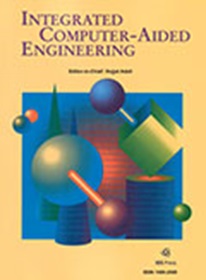Hybrid parallelization of the black hole algorithm for systems on chip
IF 5.3
2区 计算机科学
Q1 COMPUTER SCIENCE, ARTIFICIAL INTELLIGENCE
引用次数: 0
Abstract
Black Hole (BH) is a bioinspired metaheuristic algorithm based on the theory of relativity in which a sufficiently compact mass can deform the space-time to form a black hole, where no particles or electromagnetic radiation can escape from it. Thus, such an approach is based on the concept of a population of individuals (stars) representing solutions for a given computational problem to be optimized. In the literature, such an approach has been used to solve clustering problems, among others, since it is parameter-free and simple to implement. In this article, due to such characteristics, a hybrid solution, in software/hardware, of parallelization of the BH algorithm is proposed, aiming at accelerating its processing in hardware through a methodology that allows any user, even non-expert, implement hardware accelerators, for optimization problems, among others, through a high level tool. A System on Chip (SoC) platform was used for this implementation, containing a Zynq chip from Xilinx, which has two ARM cores and an FPGA. The BH Algorithm was implemented in software first and then in hardware for runtime comparison purposes to validate this approach. Also, in this paper, simpler and more popular optimization algorithms, such as Particle Swarm Optimization (PSO), Gravitational Search (GSA), and Big Bang – Big Crunch (BB-BC), along with simpler datasets, were used for comparison purposes, due to its ease of implementation and to keep a fairer comparison with BH as realized in other works in the literature. Therefore, the results obtained were satisfactory in terms of execution time and quality, with an average speedup of 25 times compared to the same implementation in software. In the future, it is intended to use this procedure to implement more recent clustering and optimization algorithms with larger datasets as well.片上系统黑洞算法的混合并行化
黑洞(BH)是一种基于相对论的生物启发的元启发式算法,其中足够紧凑的质量可以使时空变形形成黑洞,没有粒子或电磁辐射可以从中逃脱。因此,这种方法是基于个体(星形)群体的概念,这些个体(星形)代表要优化的给定计算问题的解决方案。在文献中,这种方法已被用于解决聚类问题,因为它没有参数并且易于实现。在这篇文章中,由于这样的特点,在软件/硬件中提出了并行化BH算法的混合解决方案,旨在通过一种方法加速其在硬件中的处理,这种方法允许任何用户,甚至是非专家,实现硬件加速器,通过高级工具来优化问题等。该实现使用了片上系统(SoC)平台,包含Xilinx的Zynq芯片,该芯片具有两个ARM内核和一个FPGA。BH算法首先在软件中实现,然后在硬件中实现,用于运行时比较,以验证该方法。此外,在本文中,更简单和更流行的优化算法,如粒子群优化(PSO)、引力搜索(GSA)和大爆炸-大紧缩(BB-BC),以及更简单的数据集,被用于比较目的,因为它易于实现,并保持与黑洞的公平比较,在其他文献中实现的工作。因此,所获得的结果在执行时间和质量方面都是令人满意的,与软件中相同的实现相比,平均加速提高了25倍。在未来,它打算使用这个过程来实现更大数据集的最新聚类和优化算法。
本文章由计算机程序翻译,如有差异,请以英文原文为准。
求助全文
约1分钟内获得全文
求助全文
来源期刊

Integrated Computer-Aided Engineering
工程技术-工程:综合
CiteScore
9.90
自引率
21.50%
发文量
21
审稿时长
>12 weeks
期刊介绍:
Integrated Computer-Aided Engineering (ICAE) was founded in 1993. "Based on the premise that interdisciplinary thinking and synergistic collaboration of disciplines can solve complex problems, open new frontiers, and lead to true innovations and breakthroughs, the cornerstone of industrial competitiveness and advancement of the society" as noted in the inaugural issue of the journal.
The focus of ICAE is the integration of leading edge and emerging computer and information technologies for innovative solution of engineering problems. The journal fosters interdisciplinary research and presents a unique forum for innovative computer-aided engineering. It also publishes novel industrial applications of CAE, thus helping to bring new computational paradigms from research labs and classrooms to reality. Areas covered by the journal include (but are not limited to) artificial intelligence, advanced signal processing, biologically inspired computing, cognitive modeling, concurrent engineering, database management, distributed computing, evolutionary computing, fuzzy logic, genetic algorithms, geometric modeling, intelligent and adaptive systems, internet-based technologies, knowledge discovery and engineering, machine learning, mechatronics, mobile computing, multimedia technologies, networking, neural network computing, object-oriented systems, optimization and search, parallel processing, robotics virtual reality, and visualization techniques.
 求助内容:
求助内容: 应助结果提醒方式:
应助结果提醒方式:


